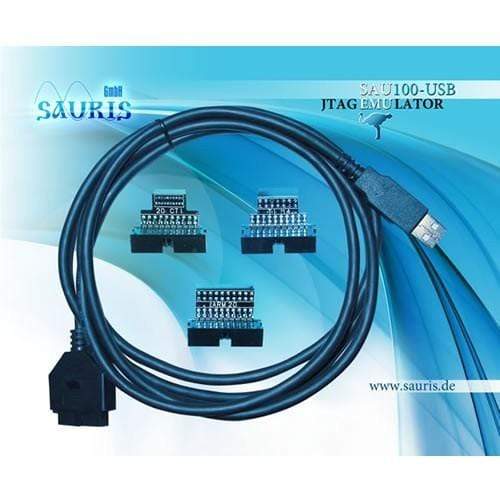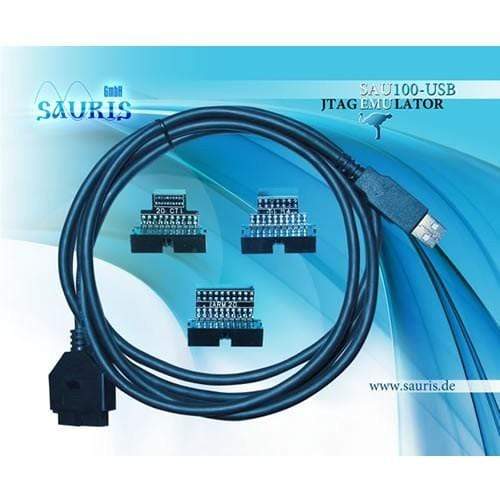
Key Features
Overview
The Sauris SAU100-USB v1 delivers professional-grade JTAG debugging capabilities at an accessible price point, making it ideal for students, hobbyists, and budget-conscious developers. This ultra-compact emulator connects via standard USB 2.0 and provides full XDS100v2 class functionality for Texas Instruments processor families including C2000, C5000, C6000, ARM Cortex-M, ARM Cortex-R, and ARM Cortex-A series devices.
Compatible with Code Composer Studio V4 and all subsequent versions, the SAU100-USB requires no external power source and features automatic target voltage detection from 1.8V to 3.3V. The 14-pin TI JTAG connector ensures broad compatibility with development boards and evaluation modules from Texas Instruments and third-party manufacturers.
This is the original v1 model in the SAU100 series.
Downloads
Why Engineers Choose The Sauris SAU100-USB v1 JTAG Emulator
Budget-Friendly Professional Tool
Plug-and-Play Simplicity
Broad TI Compatibility
Professional JTAG Debugging Made Affordable
The Sauris SAU100-USB v1 is a compact, USB-powered JTAG emulator providing professional debugging capabilities for Texas Instruments microcontrollers and DSPs at an exceptional price point. Built to XDS100v2 class specifications, this emulator delivers reliable real-time debugging, code download, and programming functionality through a simple USB 2.0 connection.
Texas Instruments Compatibility
Engineered specifically for TI processor families, the SAU100-USB supports comprehensive debugging across multiple architectures including C2000, C5000, C6000, ARM Cortex-M, ARM Cortex-R, and ARM Cortex-A series processors. Full compatibility with Code Composer Studio V4 and newer versions ensures seamless integration into existing development workflows.
Wiring Quick-Start
Pin Assignment (TI 14-pin JTAG Header): Pin 1: TMS (Test Mode Select) Pin 2: nTRST (Test Reset) Pin 3: TDI (Test Data In) Pin 4: TDIS (Test Disconnect) Pin 5: VTRef (Voltage Reference) Pin 6: KEY (No Connection) Pin 7: TDO (Test Data Out) Pin 8: GND (Ground) Pin 9: RTCK (Return Test Clock) Pin 10: GND (Ground) Pin 11: TCK (Test Clock) Pin 12: GND (Ground) Pin 13: EMU0 (Emulation Pin 0) Pin 14: EMU1 (Emulation Pin 1) Development Environment Integration
The SAU100-USB integrates directly with Code Composer Studio through standard XDS drivers, eliminating complex setup procedures. USB bus-powered operation requires no external power supply, whilst the compact form factor minimises desk space requirements. LED status indicators provide immediate visual feedback on connection status and emulation activity.
Ready-to-Run Code Example
// Basic CCS connection verification #include "DSP28x_Project.h"
void main(void) {
InitSysCtrl(); // Initialize system con
rol InitGpio(); // Initial
ze GPIO DINT; // Disable globa
interrupts InitPieCtrl(); // Initia
ize PIE control IER = 0x0000; // Di
able CPU interrupts IFR = 0x0000;
Data format:
text
// Enable JTAG debug mode
SysCtrlRegs.PCLKCR0.bit.TBCLKSYNC = 0;
EINT; // Enable global interrupts
while(1) {
// Debug breakpoint location
asm(" NOP"); // Set breakpoint here
}
}
| General Information | |
|---|---|
Part Number (SKU) |
SAU100-USB
|
Manufacturer |
|
| Physical and Mechanical | |
Weight |
0.5 kg
|
| Other | |
Warranty |
|
Country of Origin |
|
HS Code Customs Tariff code
|
|
EAN |
5055383606788
|
Frequently Asked Questions
Have a Question?
-
How do I troubleshoot connection issues?
First, verify target power and proper JTAG cable connections. Check that the correct target configuration is selected in CCS and that your processor is in the supported device list. Ensure no other debuggers are connected simultaneously.
-
Is the SAU100-USB v1 compatible with Linux or Mac operating systems?
The emulator works with Code Composer Studio on Windows, Linux, and Mac platforms where CCS is supported. However, driver availability may vary by platform, with Windows offering the most comprehensive support.
-
What cable length limitations should I observe?
For optimal signal integrity, keep the JTAG cable connection under 15cm (6 inches) when possible. Longer cables may cause connection reliability issues, particularly at higher clock speeds or in electrically noisy environments.
-
Can I use this emulator with custom target boards?
Yes, provided your target board includes a standard TI 14-pin JTAG header and meets basic electrical requirements. Ensure proper ground connections and that your target processor is supported by the XDS100v2 class emulation.
-
How does the SAU100-USB v1 compare to more expensive JTAG emulators?
Whilst offering excellent value, the SAU100-USB v1 has slower code download speeds compared to XDS510 or XDS560 class emulators. It provides essential debugging features including breakpoints, single-step execution, and memory access, making it ideal for development work where speed is less critical.
-
What target voltages are supported?
The emulator automatically detects and supports target systems operating at 1.8V, 2.5V, 3.0V, and 3.3V logic levels. Voltage detection occurs through the VTRef pin on the JTAG connector.
-
Does the emulator require external power or drivers?
No external power supply is needed - the device is USB bus-powered. Standard XDS drivers are included with Code Composer Studio V4+, though specific Sauris drivers may be required for optimal performance and can be downloaded from the manufacturer's website.
-
Which versions of Code Composer Studio work with this emulator?
The SAU100-USB v1 requires Code Composer Studio V4.0 or newer. It is not compatible with legacy CCS V3.3. The emulator uses standard TI XDS drivers that are automatically installed with modern CCS versions.
-
What Texas Instruments processors does the SAU100-USB v1 support?
The emulator supports TI's C2000 (TMS320F28x), C5000 (TMS320C54x, C55x), C6000 (TMS320C64x+, C674x), ARM Cortex-M, ARM Cortex-R4, and ARM Cortex-A8 processor families. It's fully compatible with most TI development boards using the standard 14-pin JTAG header.

